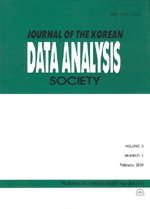신용등급 변화감지에 관한 방법 개발 연구
A Study on Validating the Calibration of the Internal Rating System
- 한국자료분석학회
- Journal of The Korean Data Analysis Society (JKDAS)
- Vol.11 No.2
-
2009.04827 - 837 (11 pages)
- 5

신BIS 기준에 따라 금융회사는 내부등급법을 사용할 경우 신용평가모형에 대한 적합성에 대한 일정 수준의 검증을 거칠 필요가 있다. 본 연구에서는 여러 가지 양적 적합성검증 중 계량화에 대한 검증 방법 개발을 목적으로 한다. 신용등급의 변화감지 문제 해결을 위해, 통계적 접근이 용이한 정규 검정과 직관적으로 이해가 쉬워 많이 사용하고 있는 확장된 신호등 검정에 대한 대안으로 p값을 이용한 검정 방법을 제시한다. 이항 검정을 바탕으로 여러 기간 검증으로 확장하는 p값 접근법은 다년간의 부도 발생건수를 고려하여 유의확률을 계산하는 방법이다. 포트폴리오 내 자산이 서로 상관관계가 여부에 따른 p값 검정 방법에 대해 설명하고 정규 검정, 확장된 신호등 검정 결과와 비교하여 장단점을 파악한다. p값 접근법은 자산 간의 상관관계를 가정하는 경우가 자산 간의 상관관계가 없다고 가정한 것보다 합리적인 결과가 나왔으며 확장된 신호등 검정법에 비해 기간별 관측 부도율에 민감하게 반응하여 결과를 도출하면서도 정규 검정에 비해 등급의 계량화가 잘못 되었을 경우 귀무가설을 기각하는 경향이 강한 것을 확인할 수 있었다.
When following the internal ratings-based approach, banking institutions are allowed to use their own internal measures for key drivers of credit risk subject to meeting certain conditions. In this article, methods for validating calibrations are considered among various quantitative methodologies for validating the internal rating system. I suggest a p-value approach to validate the calibration of a rating system instead of the widely used ETLA test. In case defaults are correlated, the p-value approach is adapted in calculating p-values and the results may be different. I simulate the test with ideal data sets and compare the results of p-value approach with those of normal test and ETLA test. P-value approach with default dependency assumption is more appropriate than that without the assumption. I observed p-value approach is more sensitive to the observed default rate and is more apt to reject the null hypothesis than the normal test.
1. 서론
2. 계량화검증 방법
3. p값 접근법
4. 검정 결과 비교
5. 결론
참고문헌
(0)
(0)